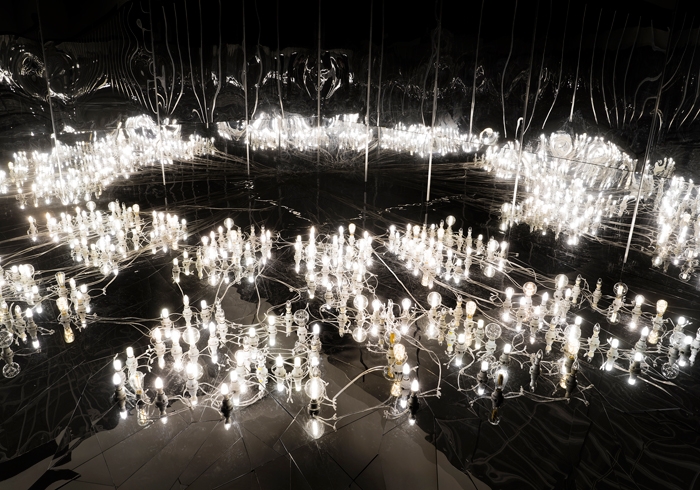Feminist science-fiction has long played on the idea that women are liberated when humans are confronted with other intelligences. Gender – not to mention ethnicity and class – is constructed differently when the field of relations encompasses monsters, cyborgs, artificial intelligences and animals. The coalitions between those minorities that are a feature of the genre entail remodelled social formations and alternative modes of communication – hybrid languages and new codes of behaviour – that challenge the dominant (meaning white, patriarchal, monolithic) culture. Neologism, hybridity and untranslatability are in these speculative futures symptoms of progress.
It’s appropriate, then, that the Latin phrase ‘Civitas Solis’ – spelled out in English and Korean by lightbulbs planted into the mirrored floor of Lee Bul’s eponymous 2014 installation – should remain illegible to visitors entering London’s Hayward Gallery. Refracted by the cracked ground on which they are written, and obscured by the tendrils of a monstrous tree sprouting up from the edge of the stage, the characters more closely resemble a constellation of stars – repository of arcane or esoteric knowledge – than a decipherable sentence. In applying the title of Tommaso Campanella’s sixteenth-century utopia to a vision that embraces fragmentation and incoherence – what Luce Irigaray called the ‘disconcerting of language and logic’ – Civitas Solis II introduces a body of work that has over the course of 30 years circled back to the problem of communication and the construction of truth.
The installation is watched over by a host of bodies suspended by wires from the gallery ceiling. Gleaming white Cyborgs (1998) hang alongside the freakish costumes in which Lee delivered her early performances. The former conjure the idealised female bodies enshrined in Greek statuary (and the modern European assumption that their whiteness denoted perfection rather than deterioration), hypersexualised manga characters and a near-future in which the body is inseparable from machine. A naked human figure dangles amidst these fantastic creatures and – echoing Michelangelo’s eviscerated self-portrait in the Last Judgment (1537–41) – strikes an opening note of anxiety about what it might mean to occupy a body in a posthuman world.
Reimagining society requires a radical reconfiguration of self, and so the three poised, severed, silicone hands of Alibi (1994) – while playing on orientalised ideals of the female Asian body – might also suggest the disarticulated body as one expression of a broader aesthetic of incompleteness. This recombinatory approach also informs the utopian architectures of Sternabau No. 2 (2007) and After Bruno Taut (Devotion to Drift) (2013), which combine Modernism and mysticism in a transformative vision of the future. These sprawling model superstructures – inspired by a socialist German Jewish architect who fled Nazism for Japan – offer further examples of how hybrid identities might inform the configuration of new societies.
The achronological installation of Crashing – which across five rooms intermingles video documentation of Lee’s early, provocative performances in a country in slow transition from dictatorship to democracy, nightmarish biomorphic sculpture indebted to Louise Bourgeois and more spectacular recent installations – is appropriate to a practice in which the unsettled past continually irrupts into the present (and future). The political implications are most explicit in Thaw (Takaki Masao) (2007), which depicts a lifesize Park Chung-hee trapped inside a block of ice resembling an uncut diamond. If the ex-president’s cryogenically preserved grin implies that his 1979 assassination heralded only a brief interregnum, then he was – if we take a dynastic view of history – vindicated by the ascent of his daughter to the South Korean presidency in 2013. That she too is now imprisoned after conviction for corruption, albeit in a more conventional institution, only reinforces the sense that Lee’s speculative fictions represent the most effective means of critiquing a rigged reality.
Lee Bul: Crashing at Hayward Gallery, London, 1 June – 19 August
From the Summer 2018 issue of ArtReview Asia
